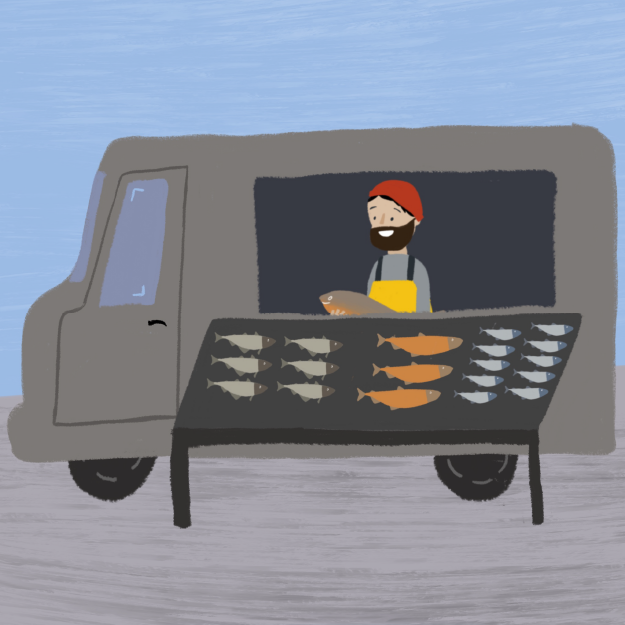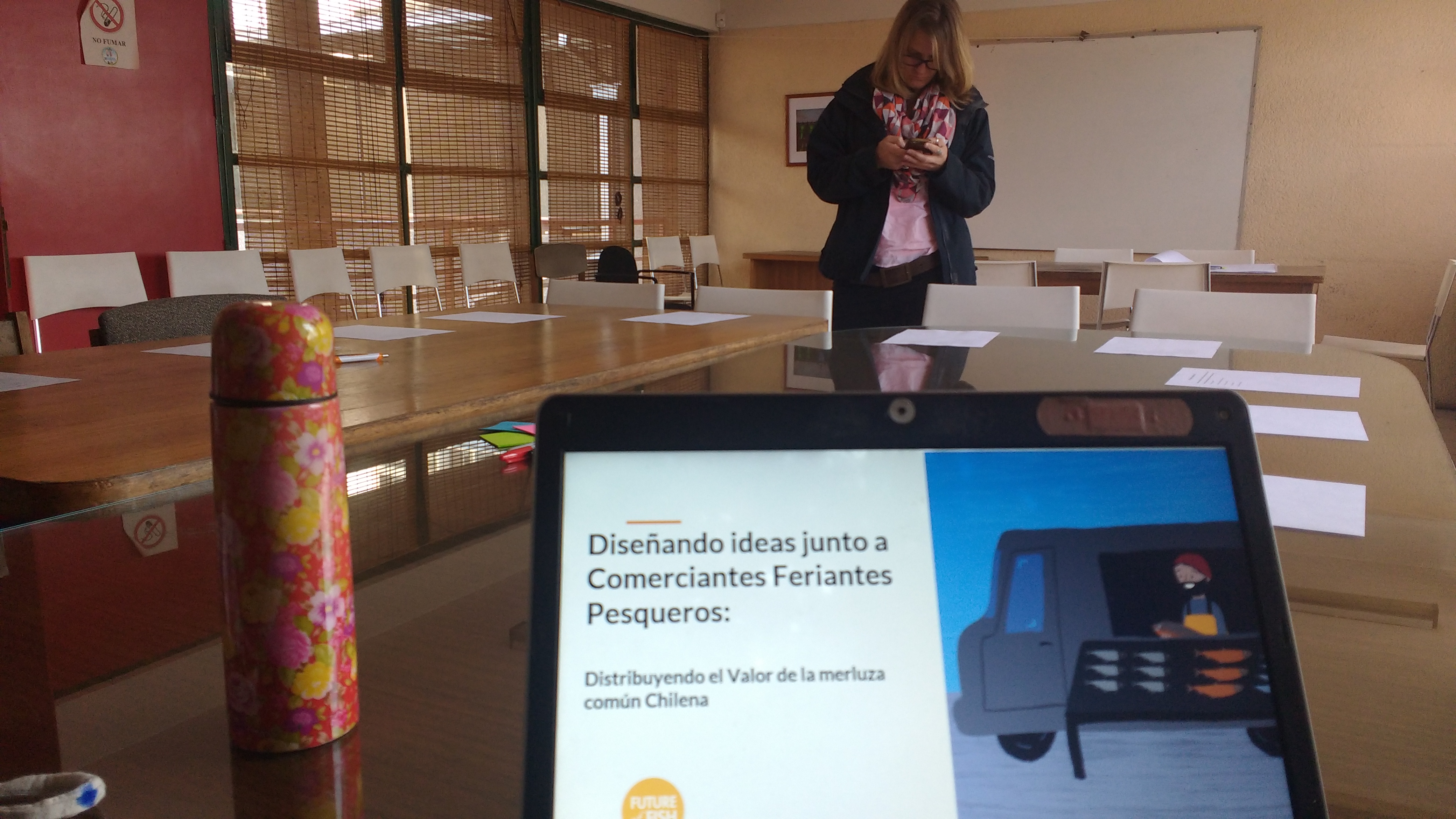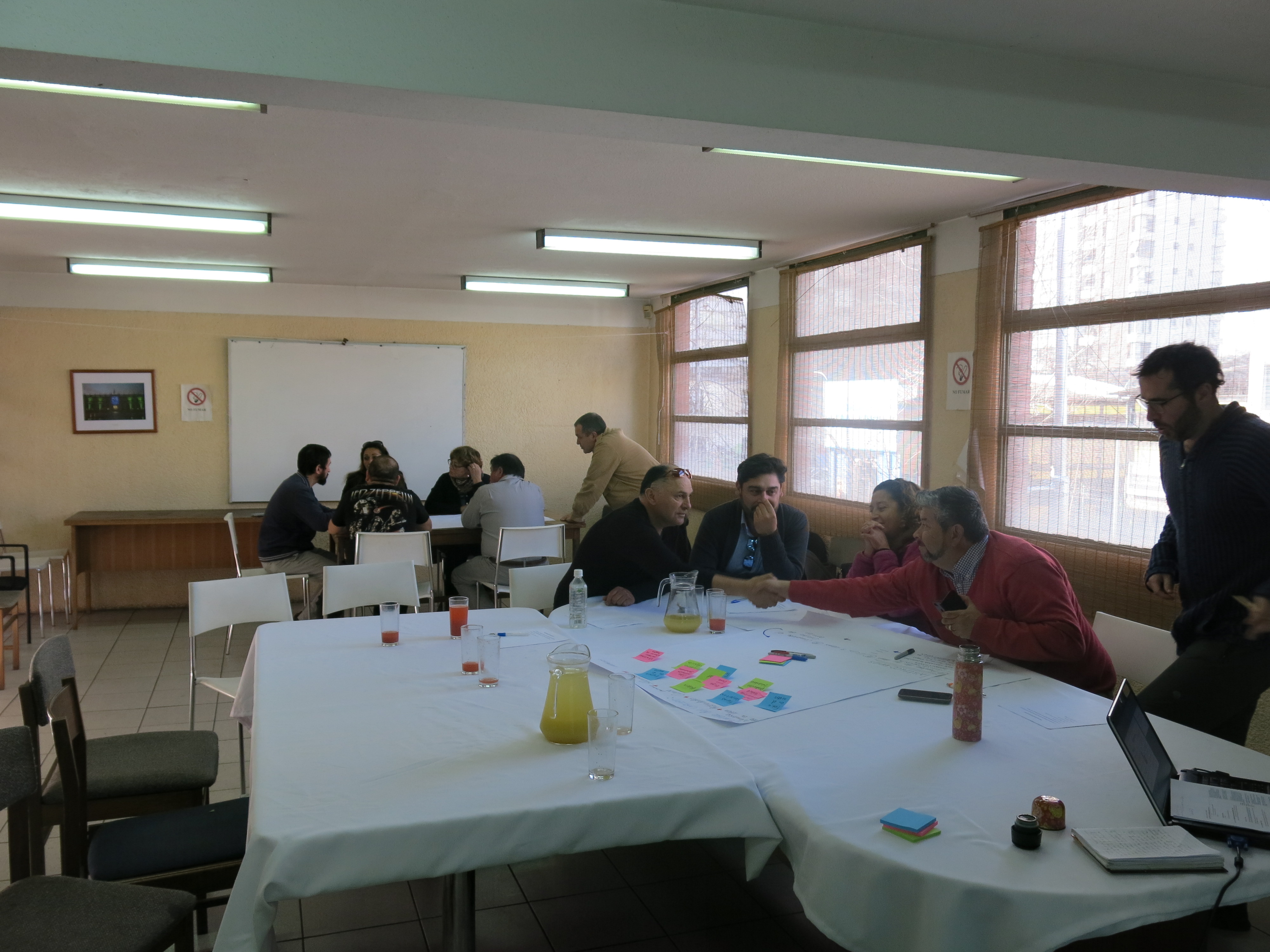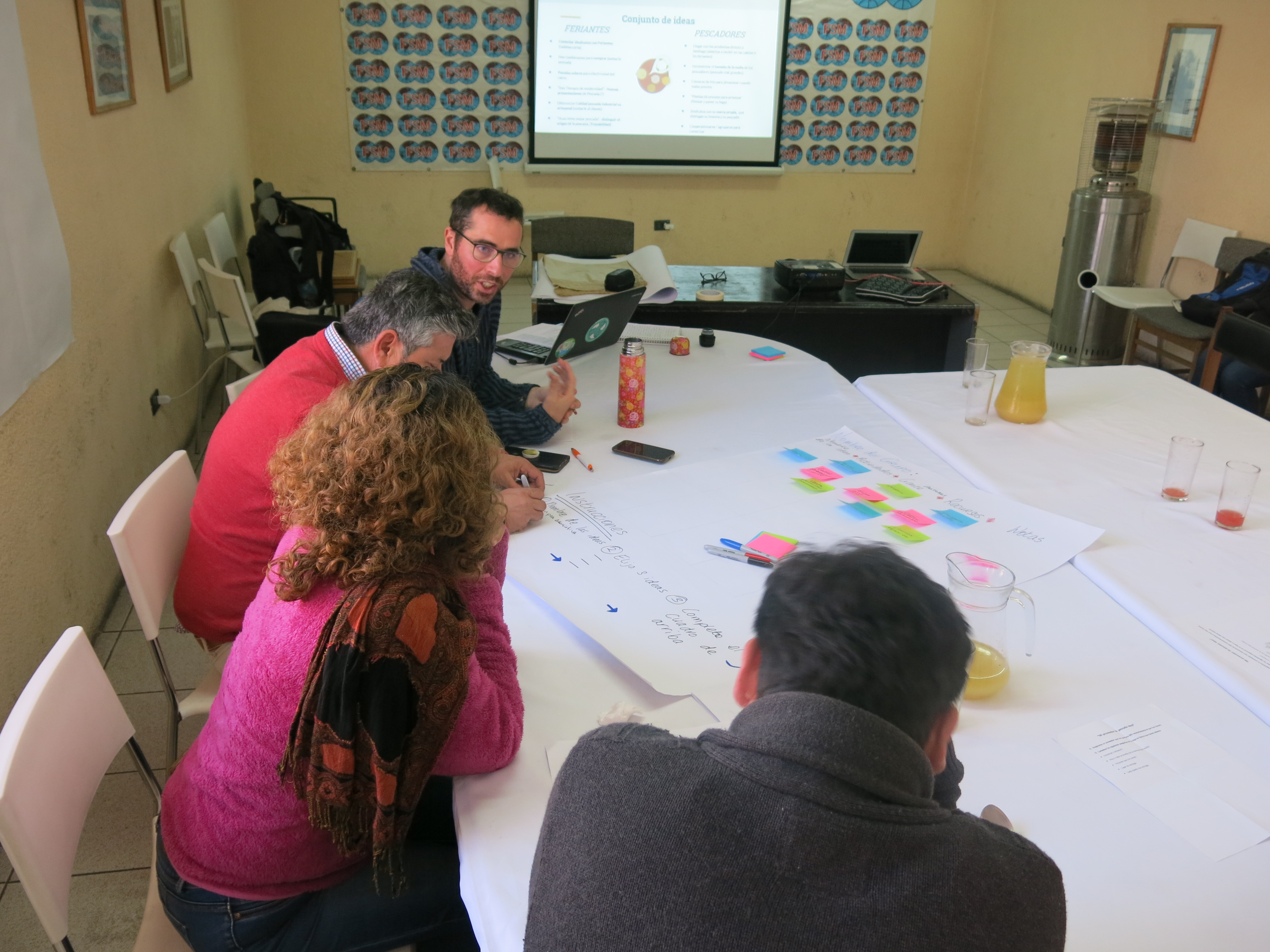
by Iván Greco, Research Associate at Future of Fish
Versión en Español incluída
Chilean Artisanal Hake Value chains 101
It seems easy in theory, but the practice of sourcing seafood is incredibly complicated. How does fish travel from the water to the consumer's table? Usually the description of that path is called the value or supply chain, which includes everyone from those who extract it, to those who transport it. There are also other "nodes"; the ones that sell it to wholesale markets and then to small vendors. Embedded in all this are asymmetric power relations and businesses that have thrived on them, as we have described in other blogs. In the common hake fishery of Chile, our work to date has been to generate more value from the fishery resource in partnership with one of the most important nodes: those who get up every morning to extract it, the Chilean artisanal fishers. To engage artisanal fishers in thinking beyond just their ‘node’, we’re working with them to create a co-design process that immerses them in a space of ideas and people who can provide different perspectives across the entire value chain. And with that, we began looking to expand our collective understanding of the common hake value chain story.
Work on the ground is very rewarding, and we are fortunate to have built a strong relationship with Luis Solís, the general manager of ASOF (National Confederation of Open Air (OA) Markets). ASOF is the National representative for the other end of the value chain: open air vendors that are responsible for selling fish, mostly on the streets of urban centers. Luis has the difficult mission of, among other challenges, ensuring that the important and traditional roles these vendors play in Chilean culture is not overshadowed by other points of sale, generally with bigger seafood outlets such as supermarkets. To this day, sales in the open air markets are greater in volume and in value than those from competing outlets. Luis´s role requires that vendors are constantly aware of how to face the challenges that our contemporary times demand. Open air market consumers increasingly have “faster” lives, with less time to enjoy a beautiful cooking moment. Likewise, their confidence in the food safety of the products they acquire requires that the places they approach are in line with health regulations and with what "modern times" demand, like carts in good conditions, hygienic assurances and technical capacity to store fresh sea products. Of course, on top of all that, the personalized connection that vendors have towards a customer is a fundamental seasoning in this dish, something that is deeply rooted in the culture and history of Chileans, and a feature that can never be replaced in other types of mass end markets. That is their comparative advantage, in addition to selling products that nutritionally contribute to a vast amount of the Chilean population's diet.
Joining the challenge
When ASOF recognized the challenge they were facing, the group approached Future of Fish to help support their efforts. Today, the Chilean common hake value chain is fairly concentrated; controlled by powerful players, who market in a top-down way (see this blog for more details) . Despite the fact that efficiency is the dream of many top-down type players (both formal and informal)--at Future of Fish, we set ourselves the challenge of “breaking down” this top-down dynamic and promoting a more even playing field through more equitable and distributed access to these value chains. Short and more horizontal chains (in the sense of value equity) make sense for this fishery, where the domestic market is emphasized and where we try to disincentivize the concentration of power and market flow. For this reason, thanks to the invitation of ASOF, we began to work side by side with the vendors.
During the last year, we began a dialogue to work with these open air vendors. We have been visiting some of them, sometimes in their work place, and sometimes they welcomed us with all the hospitality of the world into their homes. We listened with an empathetic ear and began to see the panorama of the seafood system through their eyes. Nothing is more important to understanding a system than to sit at the same table of those who live it and are willing to share what they see as the key barriers, opportunities, assets and aspirations for the fishery. Of course, as with most groups, there is also asymmetry of power among the group of vendors themselves. This is where the eye and experience of ASOF and Luis, in selecting collaborators and champions to catalyze change, takes center stage.
Let’s do it!

Last August, together with ASOF, we organized a workshop with a pre-selected group of fish vendors who were willing to innovate and test alternatives to their current business models. We invited them to think outside their daily atmospheres and outside their space of comfort. Two members of Future of Fish (Momo, our Global Implementation Lead and myself, FOF Research Associate) and our partner Claudio Barrientos facilitated the space. Luis from ASOF hosted the workshop.
It was a half-day of pure adrenaline. First it was time for a welcome, where several vendors met each other for the first time, which was already extraordinarily positive for them. After sharing a relaxing lunch for everyone (except for myself...with a bad stomach ), we put things into first gear. Future of Fish explained to the collective of vendors the preliminary ideas, our Fisheries Development Model (FDM), and the work plan we have been carrying out together with artisanal fisher's syndicates and caletas. The enthusiasm of the people in the room was immediate. They were keenly interested in shortening distribution chains and were very respectful of Chilean artisanal fishers. They understood that the natural place for commercializing the resources that come from the caletas is in Open Air Markets. Simply put, they believe Chilean fish should travel from the caleta to the market and from the market to the Chilean table, respecting one of the most important cultural traditions in this country. It has always been like that, and the group felt we should sustain that.
Then there was room to think a little more outside the box. The market vendors were invited to split into two groups and think through (or come up with) ideas to improve the way they sell seafood, with a very fun arts and crafts type methodology, true to FoF’s style. The vendors thought of innovation ideas and, at a very high level view, they thought of strategies and resources to carry them out. "Why not think about carts that are self-sufficient in energy with solar panels?" "That would improve the storage!" They even imagined they could have lights for those dark winter days. "We could start going to the coves to talk to fishers? Yes! Why not?! ". Other powerful ideas emerged such as pooling funds for buying (perhaps under cooperative systems) which would allow more bargaining power. Finally, the idea of starting to offer other types of products for a clientele that (unfortunately) has less and less time to cook was on the table. As Charles Chaplin said, these are Modern Times!

On the side of the barriers, there were several logistical aspects related to distribution of the products, like those articulated by the fishers at the caletas. Local municipalities and Ministries of Health that do not listen to their problems and that attack them with inspections and bureaucratic fines, was one of the mentioned obstacles. However, listening to a colleague who they previously did not know recount the same problems they were having was an enriching conversation for the vendors, despite the frustrations coming from the problems described.
The peak of the workshop was where we had our participants present their ideas in front of the other groups. Surprisingly there were commonalities, and it is in the consensus where the collective power of the group was synergized, giving encouragement and hope to those who seek to change things at the system level. That type of discovered collective-action is something we seek to achieve in all of FoF’s work.

After the closure, it was time to think about the following steps: synthesizing this information, and coming back to work with them on actionable next steps. It is noteworthy that the enthusiastic vendors requested that the work, which was interpreted as powerful, was not discontinued. And we could not contain ourselves: our original idea was to hold a space for vendors to co-design, but why work only with the vendors? Our new mission will be focused on the fact that this space is shared with the fishers in the caletas. Yes, we know there will be challenges to putting both ends of a long supply chain at the same table; but we have the tools and willingness to shorten it and that is what it takes to face what seems impossible.
We hope you will continue accompanying us!
Feriantes: Explorando el otro lado de la cadena de valor
Por Iván Greco, Investigador Asociado en Future of Fish
Cadenas de valor de Merluza, para principiantes
Parece fácil pero no es tan obvio como parece! Cómo viaja el pescado desde al agua a la mesa de los consumidores? Usualmente la descripción de ese camino se llama cadena de valor o de suministro. Por un lado están quienes lo extraen, por el otro quienes los transportan. También se suman como “eslabones” quienes lo venden al por mayor y luego los vendedores minoristas. Todo ello conlleva relaciones asimétricas de poder y, por supuesto, concentración del negocio en quienes toman ventaja, como lo hemos descrito en otros blogs. En el caso de la Merluza común, nosotros hemos venido venimos relatando sobre nuestro trabajo para generar más valor de los recursos junto con uno de los eslabones más importantes: quienes se levantan todas las mañanas para extraerlo, los pescadores artesanales. Asimismo, les hemos comentado que estamos buscando, dentro de este trabajo, rodear a los pescadores dentro del marco de espacios de co-diseño de ideas, con gente que les aporte visiones distintas sobre las otras partes y aspectos a ser considerados en estas cadenas. Así es que comenzamos a mirar el otro lado de esta historia.
Por esas cosas maravillosas que tiene el trabajo en terreno (sumado a nuestra incesante inquietud dentro de FOF), afortunadamente hemos conocido y construido una muy buena relación con Luis Solís, el gerente general de ASOF (Confederación Gremial Nacional de Organizaciones de Ferias Libres). ASOF es uno de los mayores representantes de la otra punta de estas cadenas: los comerciantes feriantes pesqueros. Ellos son los responsables de vender el pescado, mayoritariamente en las calles de los conglomerados urbanos. Luis, entre otros desafíos, tiene la difícil misión de acompañar a este colectivo de vendedores para que su tradicional e importante rol en la cultura Chilena, no quede fuera de juego frente a otros puntos de venta, generalmente con mayor poder concentrado como los supermercados. No obstante, las ferias son el canal de venta más importante en volumen y en valor. La tarea de Luis, requiere que los feriantes constantemente estén al tanto de cómo afrontar los desafíos que los tiempos contemporáneos demandan. Los consumidores cada vez tienen vidas más aceleradas, con menos tiempos para disfrutar de un hermoso momento de cocina. Asimismo, la confianza en la inocuidad de los productos que adquieren, requiere que los lugares a los que se acercan, estén en línea con las regulaciones de sanidad y con lo que “los tiempos modernos” demandan. Carros de expendio en buen estado, condiciones higiénicas y capacidad de almacenar productos del mar 100% frescos. Por supuesto que la buena predisposición y amabilidad del vendedor en una feria al aire libre es un condimento fundamental en este plato, algo que está arraigado en la cultura e historia de los Chilenos, y una característica que jamás podrá ser reemplazada por ningún puesto dentro de otro tipo de mercado…. Esa es su ventaja comparativa número uno, sumado a que venden productos que nutricionalmente aportan mucho a la dieta de la población.
Sumarnos al desafío
Este desafío que ASOF ha tomado, generó un espacio donde FOF se ha acercado para sumar. Hoy en día la merluza común proveniente de caletas de pescadores artesanales que en muchos casos cuenta con una cadena controlada por poderosos jugadores, que son quienes comercializan en forma concentrada (de nuevo, ver este blog). Pese a que el control total de la cadena es el “sueño” de cualquier jugador concentrado (tanto formal como informal) en Future of Fish nos planteamos el desafío de rever dicha situación y darle algunos tijeretazos a esas cadenas de valor. Creemos en cadenas cortas y más justas, donde se privilegie el mercado doméstico y donde la distribución del valor de los productos sea equitativo para todos, excluyendo a jugadores excesivos (y abusivos) en la misma. Por ello, gracias a la invitación de ASOF, nos pusimos a trabajar codo a codo con los feriantes.
Durante el último año, comenzamos un trabajo de diálogo junto a los comerciantes feriantes pesqueros. Hemos ido visitando a algunos de ellos, a veces en sus puestos de trabajo, a veces nos recibieron con toda la hospitalidad del mundo, en sus hogares. Fue así que la empatía emanó y empezamos a ver el panorama que nos describían, a través de sus ojos. Nada más importante para entender un sistema que mirarlo sentados en la misma mesa de quienes lo padecen. Comenzamos a entender partes de sus barreras, oportunidades, potencialidades y aspiraciones. Por su puesto, al igual que con los pescadores, como en todo espacio, hay asimetría de poder entre los propios comerciantes, no hay lugar para la ingenuidad aquí. Aquí es donde el ojo y la experiencia de ASOF y Luis, para la selección de los actores proclives a generar cambios, toma protagonismo…
Manos a la obra

Con una preselección de Comerciantes feriantes pesqueros dispuestos a innovar y a probar alternativas a sus negocios actuales, fue que el pasado Agosto, organizamos junto a la ASOF un taller con comerciantes feriantes pesqueros donde los invitamos a pensar fuera de sus ámbitos cotidianos y fuera de su espacio de comodidad. Dos Integrantes de Future of Fish (Momo y quien les escribe) y nuestro socio Claudio Barrientos facilitaron el mismo. Luis fue el anfitrión.
Fue una media jornada a pura adrenalina. Primero fue momento de una bienvenida, donde varios feriantes se conocieron entre sí por primera vez, lo cual ya fue extraordinariamente positivo para ellos. Luego de compartir un almuerzo descontracturante para todos (menos para mí que estaba mal del estómago), pusimos primera marcha. Future of Fish explicó a los feriantes sus ideas, su Modelo de Desarrollo de Pesquerías, y el plan de trabajo que venimos llevando a cabo junto a Sindicatos de pescadores artesanales. El entusiasmo de los feriantes no se hizo esperar. Ellos son principales interesados en acortar cadenas de distribución y son muy respetuosos de la pesca artesanal Chilena. Entienden que el lugar de venta de los productos que vienen de las caletas de pescadores es naturalmente el de las ferias libres. Simple: de la caleta a la feria y de la feria a la mesa Chilena, respetando una de las tradiciones culturales más importantes en este país. Siempre fue así, debe haber sostenibilidad en ello.
Luego hubo lugar para pensar un poco más creativamente. Se invitó a los feriantes a separarse en dos grupos y plasmar ideas para mejorar la manera en la que comercializan productos del mar. Con una metodología muy divertida, fiel a nuestro estilo, los feriantes pensaron ideas de innovación y muy a vuelo de pájaro, pensaron en estrategias y recursos para llevar las mismas a cabo. “Por qué no pensar en carros que se autoabastecen de energía con paneles solares?” “Eso mejoraría la refrigeración!” Hasta imaginaron podrían tener luces para esos días oscuros de Invierno. “Nosotros?... yendo a las caletas a conversar con pescadores? Por qué no!” Las ideas fueron tan potentes que surgieron ideas de compras conjuntas (tal vez bajo sistemas de cooperativas?) para tener otro poder de negociación y la idea de comenzar a ofrecer otro tipo de productos para una clientela que (desafortunadamente) tiene cada vez menos tiempo para cocinar un pescado que no esté listo para cocinar. Ya lo dijo Charles Chaplin, son los Tiempos Modernos!...

Por el lado de los problemas, siempre el tema logístico en cuanto a la distribución, al igual que lo manifestado por las caletas de pescadores, emerge. Municipalidades y Ministerios de Salud que no escuchan sus problemáticas y que los atacan con inspecciones y multas burocráticas, fue otro de los obstáculos mencionados. No obstante, escuchar los mismos problemas de colegas que antes no conocían, fuera para los feriantes una enriquecedora conversación, pese a las frustraciones con las que se encuentran a menudo.
El momento cumbre del evento fue el que los tuvo como protagonistas para exponer sus ideas frente al otro grupo. Sorpresivamente hubo coincidencias, y es en el consenso donde el poder colectivo se sinergiza, dando aliento y esperanza a quienes buscan cambiar las cosas a nivel de sistema. Ese es un valor que compartimos en FOF.

Luego del cierre, fue hora de pensar en los siguientes pasos: sistematizar esta información, y volver a trabajar junto a ellos en un plazo no muy distante. Es de destacar que los entusiasmados feriantes, solicitaron que el trabajo tan potente de ese día no quedase discontinuo. Y no pudimos contenernos: Nuestra idea es que exista un nuevo espacio de co-diseño, pero, por qué trabajar sólo con los feriantes? Nuestra nueva misión es que ese espacio se comparta con los pescadores en las caletas. Sí, nos animamos a juntar las puntas de esa laaaarga cadena, tenemos la sierra para recortarla y animarnos a lo que parece imposible.
Esto sucedió durante Octubre, pero es ya es parte de posteos de blog venideros.
Esperamos que nos sigan acompañando!



